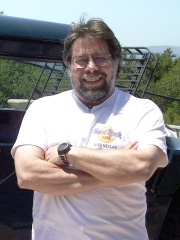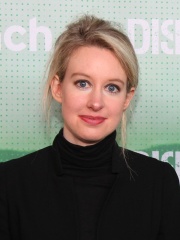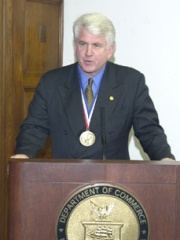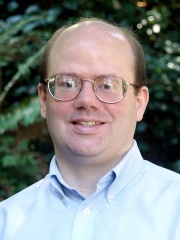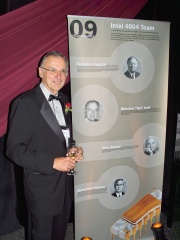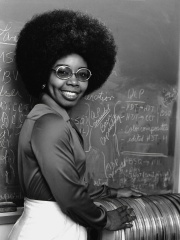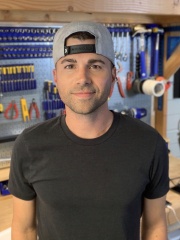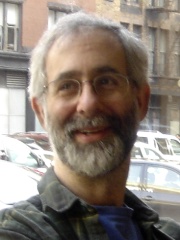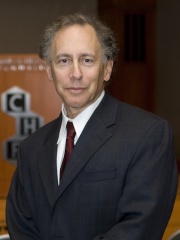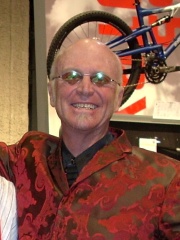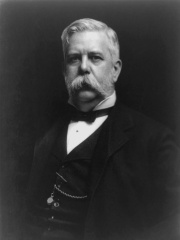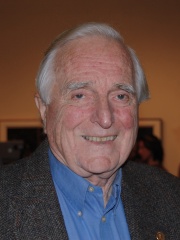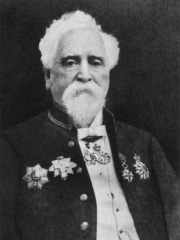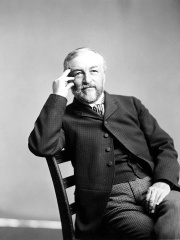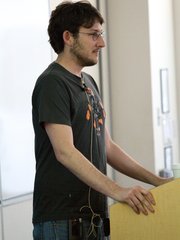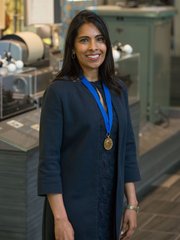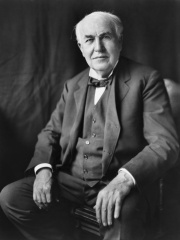

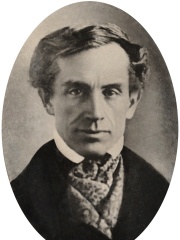
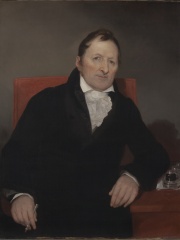

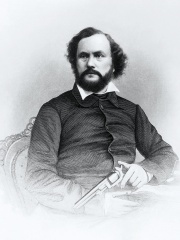
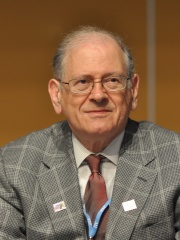
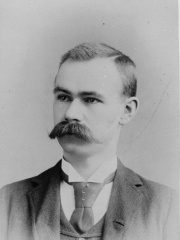
The Most Famous
INVENTORS from United States
This page contains a list of the greatest American Inventors. The pantheon dataset contains 426 Inventors, 135 of which were born in United States. This makes United States the birth place of the most number of Inventors.
Top 10
The following people are considered by Pantheon to be the top 10 most legendary American Inventors of all time. This list of famous American Inventors is sorted by HPI (Historical Popularity Index), a metric that aggregates information on a biography's online popularity. Visit the rankings page to view the entire list of American Inventors.

1. Thomas Edison (1847 - 1931)
With an HPI of 91.65, Thomas Edison is the most famous American Inventor. His biography has been translated into 189 different languages on wikipedia.
Thomas Alva Edison (February 11, 1847 – October 18, 1931) was an American inventor and businessman. He developed many devices in fields such as electric power generation, sound recording, and motion pictures. These inventions, which include the phonograph, the motion picture camera, and early versions of the electric light bulb, have had a widespread impact on the modern industrialized world. He was one of the first inventors to apply the principles of organized science and teamwork to the process of invention, working with many researchers and employees. He established the first industrial research laboratory. Edison was raised in the American Midwest. Early in his career he worked as a telegraph operator, which inspired some of his earliest inventions. In 1876, he established his first laboratory facility in Menlo Park, New Jersey, where many of his early inventions were developed. He went into business and became wealthy. Edison used his fortune to further his passion for invention. This was realized in experimental mining operations, the first film studio, and 1,093 US patents.

2. Henry Ford (1863 - 1947)
With an HPI of 82.33, Henry Ford is the 2nd most famous American Inventor. His biography has been translated into 148 different languages.
Henry Ford (July 30, 1863 – April 7, 1947) was an American industrialist and business magnate. As the founder of the Ford Motor Company, he is credited as a pioneer in making automobiles affordable for middle-class Americans through the system that came to be known as Fordism. In 1911, he was awarded a patent for the transmission mechanism that would be used in the Ford Model T and other automobiles. Ford was born in a farmhouse in Springwells Township, Michigan, and left home at the age of 16 to find work in Detroit. It was a few years before this time that Ford first experienced automobiles, and throughout the later half of the 1880s, he began repairing and later constructing engines, and through the 1890s worked with a division of Edison Electric. He founded the Ford Motor Company in 1903 after prior failures in business, but success in constructing automobiles. The introduction of the Ford Model T vehicle in 1908 is credited with having revolutionized both transportation and American industry. As the sole owner of the Ford Motor Company, Ford became one of the wealthiest people in the world. He was also among the pioneers of the five-day work-week. Ford believed that consumerism could help to bring about world peace. His commitment to systematically lowering costs resulted in many technical and business innovations, including a franchise system, which allowed for car dealerships throughout North America and in major cities on six continents. Ford was known for his pacifism during the first years of World War I, although during the war his company became a major supplier of weapons. He promoted the League of Nations. In the 1920s, Ford promoted antisemitism through his newspaper The Dearborn Independent and the book The International Jew. He opposed his country's entry into World War II, and served for a time on the board of the America First Committee. After his son Edsel died in 1943, Ford resumed control of the company, but was too frail to make decisions and quickly came under the control of several of his subordinates. He turned over the company to his grandson Henry Ford II in 1945. Upon his death in 1947, he left most of his wealth to the Ford Foundation and control of the company to his family.

3. Samuel Morse (1791 - 1872)
With an HPI of 80.49, Samuel Morse is the 3rd most famous American Inventor. His biography has been translated into 92 different languages.
Samuel Finley Breese Morse (April 27, 1791 – April 2, 1872) was an American inventor and painter. After establishing his reputation as a portrait painter, Morse, in his middle age, contributed to the invention of a single-wire telegraph system based on European telegraphs. He was a co-developer and the namesake of Morse code in 1837 and helped to develop the commercial use of telegraphy.

4. Eli Whitney (1765 - 1825)
With an HPI of 76.75, Eli Whitney is the 4th most famous American Inventor. His biography has been translated into 44 different languages.
Eli Whitney Jr. (December 8, 1765 – January 8, 1825) was an American inventor, widely known for inventing the cotton gin in 1793, one of the key inventions of the Industrial Revolution that shaped the economy of the Antebellum South. Whitney's invention made upland short cotton into a profitable crop, which strengthened the economic foundation of slavery in the United States and prolonged the institution. Despite the social and economic impact of his invention, Whitney lost much of his profits in legal battles over patent infringement for the cotton gin. Thereafter, he turned his attention to securing contracts with the government in the manufacture of muskets for the newly formed United States Army. He continued making arms and inventing until his death in 1825.
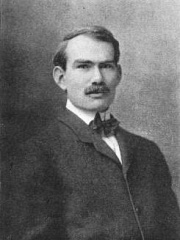
5. Lee de Forest (1873 - 1961)
With an HPI of 76.60, Lee de Forest is the 5th most famous American Inventor. His biography has been translated into 52 different languages.
Lee de Forest (August 26, 1873 – June 30, 1961) was an American inventor, electrical engineer and an early pioneer in electronics of fundamental importance. He invented the first practical electronic amplifier, the three-element "Audion" triode vacuum tube in 1908. This helped start the Electronic Age, and enabled the development of the electronic oscillator. These made radio broadcasting and long distance telephone lines possible, and led to the development of talking motion pictures, among countless other applications. He had over 300 patents worldwide, but also a tumultuous career – he boasted that he made, then lost, four fortunes. He was also involved in several major patent lawsuits, spent a substantial part of his income on legal bills, and was even tried (and acquitted) for mail fraud. Despite this, he was recognised for his pioneering work with the 1922 IEEE Medal of Honor, the 1923 Franklin Institute Elliott Cresson Medal and the 1946 American Institute of Electrical Engineers Edison Medal.

6. Jimmy Wales (b. 1966)
With an HPI of 75.20, Jimmy Wales is the 6th most famous American Inventor. His biography has been translated into 185 different languages.
Jimmy Donal "Jimbo" Wales (born August 7, 1966) is an American Internet entrepreneur and former financial trader. Most notably, he co-founded Wikipedia, a nonprofit free encyclopedia, and Fandom (formerly Wikia), a for-profit wiki hosting service. He has also worked on Bomis, Nupedia, WikiTribune, and Trust Café (formerly WT Social). Born in Huntsville, Alabama, Wales attended Randolph School and earned finance degrees from Auburn University and the University of Alabama. While in graduate school, he taught at two universities, but left before completing a PhD to work in finance, later becoming chief research officer at Chicago Options Associates. In 1996, he co-founded Bomis, which funded the free peer-reviewed encyclopedia Nupedia (2000–2003). On January 15, 2001, with Larry Sanger and others, he launched Wikipedia, which grew rapidly. Wales became its promoter and public face, though he has at times disputed Sanger's role, claiming sole founder status. Wales has served on the Wikimedia Foundation Board of Trustees since its creation, holding its board-appointed "community founder" seat. He gives annual "State of the Wiki" addresses at Wikimania. For his role in creating Wikipedia, Time named him one of the 100 most influential people in the world in 2006.

7. Samuel Colt (1814 - 1862)
With an HPI of 74.94, Samuel Colt is the 7th most famous American Inventor. His biography has been translated into 67 different languages.
Samuel Colt (; July 19, 1814 – January 10, 1862) was an American inventor, industrialist, and businessman who established Colt's Patent Fire-Arms Manufacturing Company and made the mass production of revolvers commercially viable. Colt's first two business ventures were producing firearms in Paterson, New Jersey, and making underwater mines. His business expanded rapidly after 1847, when the Texas Rangers ordered 1,000 revolvers during the American war with Mexico. During the American Civil War, his factory in Hartford supplied firearms both to the North and the South. Later, his firearms were used widely during the settling of the western frontier. When Colt died in 1862, he was one of the wealthiest men in the United States. Colt's manufacturing methods were at the forefront of the Industrial Revolution. His use of interchangeable parts helped him become one of the first to make efficient use of the assembly line manufacturing process. Moreover, his innovative use of art, celebrity endorsements, and corporate gifts to promote his wares made him a pioneer in advertising, product placement, and mass marketing.

8. Bob Kahn (b. 1938)
With an HPI of 73.96, Bob Kahn is the 8th most famous American Inventor. His biography has been translated into 39 different languages.
Robert Elliot Kahn (born December 23, 1938) is an American electrical engineer who, along with Vint Cerf, first proposed the Transmission Control Protocol (TCP) and the Internet Protocol (IP), the fundamental communication protocols at the heart of the Internet. In 2004, Kahn won the Turing Award with Vint Cerf for their work on TCP/IP.

9. Herman Hollerith (1860 - 1929)
With an HPI of 73.59, Herman Hollerith is the 9th most famous American Inventor. His biography has been translated into 57 different languages.
Herman Hollerith (February 29, 1860 – November 17, 1929) was a German-American statistician, inventor, and businessman who developed an electromechanical tabulating machine for punched cards to assist in summarizing information and, later, in accounting. His invention of the punched card tabulating machine, patented in 1884, marks the beginning of the era of mechanized binary code and semiautomatic data processing systems, and his concept dominated that landscape for nearly a century. Hollerith founded a company that was amalgamated in 1911 with several other companies to form the Computing-Tabulating-Recording Company. In 1924, the company was renamed "International Business Machines" (IBM) and became one of the largest and most successful companies of the 20th century. Hollerith is regarded as one of the seminal figures in the development of data processing.
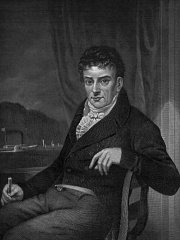
10. Robert Fulton (1765 - 1815)
With an HPI of 73.39, Robert Fulton is the 10th most famous American Inventor. His biography has been translated into 64 different languages.
Robert Fulton (November 14, 1765 – February 24, 1815) was an American engineer and inventor who is widely credited with developing the world's first commercially successful steamboat, the North River Steamboat (also known as Clermont). In 1807, that steamboat traveled on the Hudson River with passengers from New York City to Albany and back again, a round trip of 300 nautical miles (560 kilometers), in 62 hours. The success of his steamboat changed river traffic and trade on major American rivers. Fulton became interested in steam engines and the idea of steamboats in 1777 when he was around age 12 and visited state delegate William Henry of Lancaster, Pennsylvania, who was interested in this topic. Henry had learned about inventor James Watt and his Watt steam engine on an earlier visit to England. In 1800, Fulton had been commissioned by Napoleon Bonaparte, leader of France, to attempt to design a submarine; he then produced Nautilus, the first practical submarine in history. Fulton is also credited with inventing some of the world's earliest naval torpedoes for use by the Royal Navy.
People
Pantheon has 135 people classified as American inventors born between 1742 and 2005. Of these 135, 24 (17.78%) of them are still alive today. The most famous living American inventors include Jimmy Wales, Bob Kahn, and Steve Wozniak. The most famous deceased American inventors include Thomas Edison, Henry Ford, and Samuel Morse. As of April 2024, 4 new American inventors have been added to Pantheon including Thomas Knoll, Ryan Dahl, and Sangeeta Bhatia.
Living American Inventors
Go to all RankingsJimmy Wales
1966 - Present
HPI: 75.20
Bob Kahn
1938 - Present
HPI: 73.96
Steve Wozniak
1950 - Present
HPI: 73.34
Elizabeth Holmes
1984 - Present
HPI: 63.91
Robert Metcalfe
1946 - Present
HPI: 63.58
Larry Sanger
1968 - Present
HPI: 62.66
Marcian Hoff
1937 - Present
HPI: 59.63
Valerie Thomas
1943 - Present
HPI: 58.32
Mark Rober
1980 - Present
HPI: 58.03
Dan Bricklin
1951 - Present
HPI: 55.01
Robert S. Langer
1948 - Present
HPI: 53.65
Gary Fisher
1950 - Present
HPI: 52.76
Deceased American Inventors
Go to all RankingsThomas Edison
1847 - 1931
HPI: 91.65
Henry Ford
1863 - 1947
HPI: 82.33
Samuel Morse
1791 - 1872
HPI: 80.49
Eli Whitney
1765 - 1825
HPI: 76.75
Lee de Forest
1873 - 1961
HPI: 76.60
Samuel Colt
1814 - 1862
HPI: 74.94
Herman Hollerith
1860 - 1929
HPI: 73.59
Robert Fulton
1765 - 1815
HPI: 73.39
George Westinghouse
1846 - 1914
HPI: 72.92
Douglas Engelbart
1925 - 2013
HPI: 72.65
Hiram Maxim
1840 - 1916
HPI: 72.58
Samuel Pierpont Langley
1834 - 1906
HPI: 72.40
Newly Added American Inventors (2025)
Go to all RankingsThomas Knoll
1960 - Present
HPI: 43.52
Ryan Dahl
1981 - Present
HPI: 34.54
Sangeeta Bhatia
1968 - Present
HPI: 31.51
Gitanjali Rao
2005 - Present
HPI: 26.51
Overlapping Lives
Which Inventors were alive at the same time? This visualization shows the lifespans of the 25 most globally memorable Inventors since 1700.

